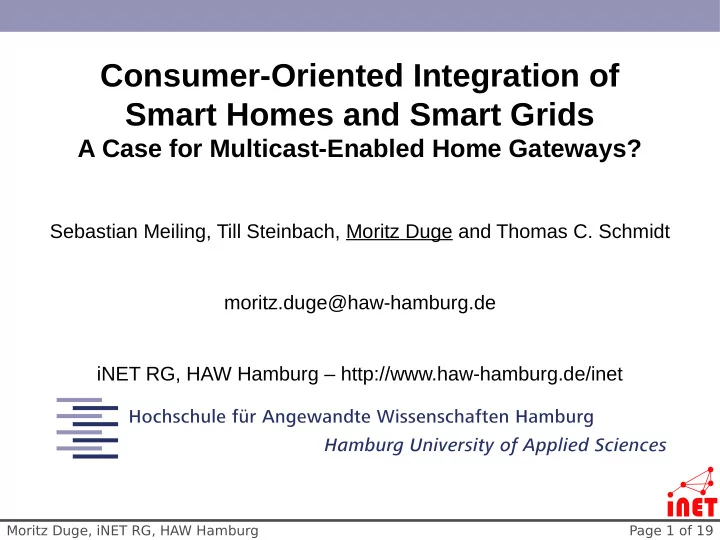

Consumer-Oriented Integration of Smart Homes and Smart Grids A Case for Multicast-Enabled Home Gateways? Sebastian Meiling, Till Steinbach, Moritz Duge and Thomas C. Schmidt moritz.duge@haw-hamburg.de iNET RG, HAW Hamburg – http://www.haw-hamburg.de/inet Moritz Duge, iNET RG, HAW Hamburg Page 1 of 19
Agenda 1. Introduction & Motivation 2. Multicast-Enabled Home Gateways 3. Deployment Considerations 4. Evaluation 5. Conclusion Moritz Duge, iNET RG, HAW Hamburg Page 2 of 19
Introduction & Motivation Smart Grid measurement and control of energy consumption ● Smart Meters at customer sites, Advanced Metering Infrastructure (AMI) ● load management by intelligent energy consumers lowering the base load capacity and avoiding peak load ● requires control of many energy devices (consumers and generators) ● load balancing by Demand Side Management (DSM) decentralized energy production ● instead of a few big power plants, many small generators ● operation of Virtual Power Plants (VPP) Moritz Duge, iNET RG, HAW Hamburg Page 3 of 19
Introduction & Motivation Smart Home and Smart Grid Smart Home & automation ● control various (energy) appliances in households ● increase comfort and reduce expenses Smart ● already some deployment Home Control Smart Grid ↔ Smart Home ● comparable motivations ● large scale ↔ small scale ● possible synergies Yet, there is no interconnection or integration! Moritz Duge, iNET RG, HAW Hamburg Page 4 of 19
Introduction & Motivation Problem Statement ● integration of Smart Homes requires communication- access to households ● dedicated communication infrastructure is expensive ● no scalable public-network infrastructure for a Smart Grid integrating Smart Homes available Moritz Duge, iNET RG, HAW Hamburg Page 5 of 19
Multicast-Enabled Home Gateways Communication Patterns in a Smart Grid one-to-many (1:N) ● device scheduling ● energy tariff information ● AMI, DSM and VPP many-to-many (M:N) ● cooperative execution of a task ● decentralized coordination ● DSM and VPP ● that is group communication ● not efficient trough unicast but multicast Moritz Duge, iNET RG, HAW Hamburg Page 6 of 19
Multicast-Enabled Home Gateways Contribution of this Work our concept ● based on consumer hardware (COTS) ● integration of Smart Home devices ● use of existing public networks, i.e. the Internet ● (hybrid) multicast-enabled home gateways – overcome limited IP multicast deployment we show ● feasibility and performance measurements ● testbed in the area of Hamburg ● evaluation of consumer internet connections Moritz Duge, iNET RG, HAW Hamburg Page 7 of 19
Multicast-Enabled Home Gateways Smart Grid using Home Gateways Moritz Duge, iNET RG, HAW Hamburg Page 8 of 19
Deployment Considerations Hybrid Multicast ● overcomes lack of IP multicast deployment ● application layer multicast using p2p technologies ● native multicast where available ∀ H Mcast hybrid adaptive multicast framework ● common multicast API with abstract group naming scheme ● adaptive middleware layer for technology abstraction ● Inter-Domain Multicast Gateways (IMGs) Moritz Duge, iNET RG, HAW Hamburg Page 9 of 19
Deployment Considerations Hybrid Multicast P2P overlay multicast enabled networks Moritz Duge, iNET RG, HAW Hamburg Page 10 of 19
Evaluation Evaluation Scenario ● system performance of home gateways ● measurement study of consumer Internet connections ● home gateway – standard consumer WLAN router – MIPS processor (400 MHz) – 32MB RAM – OpenWRT Linux operating system Moritz Duge, iNET RG, HAW Hamburg Page 11 of 19
Evaluation System Performance test setup ● two home gateways (sender and receiver) ● direct connection via 100 MBit/s Ethernet ● metrics: packet throughput and loss, CPU utilization ● constraints of hardware resources technologies under test ● native IP multicast (Native IPM) as reference ● H Mcast IP multicast (IPM) ∀ ● H Mcast application layer multicast via Scribe (ALM) ∀ Moritz Duge, iNET RG, HAW Hamburg Page 12 of 19
Evaluation System Performance Moritz Duge, iNET RG, HAW Hamburg Page 13 of 19
Evaluation System Performance CPU performance is a limit to throughput Moritz Duge, iNET RG, HAW Hamburg Page 14 of 19
Evaluation Hamburg testbed test setup ● 30 nodes ● 9 Internet service providers (ISPs) ● metropolitan area of Hamburg, Germany metric under test ● one-way message delays Moritz Duge, iNET RG, HAW Hamburg Page 15 of 19
Evaluation Distributed Measurement horizontal bars median thick bars 25% - 75% thin bars last value within: HAW thick bar + 1.5 × thick bar Moritz Duge, iNET RG, HAW Hamburg Page 16 of 19
Conclusion Conclusion ● results show high packet throughput on COTS ● end-to-end delays over ISP connections – surprisingly high for the regionally confined scenario – heavily depend on provider association – differ considerably between ISPs ● standard consumer embedded hardware more than sufficient for Smart Grid applications (AMI, DSM, and VPP) Moritz Duge, iNET RG, HAW Hamburg Page 17 of 19
Conclusion Outlook our ongoing research ● measurements and experiments in our Hamburg testbed ● analyze impacts of consumer Internet connectivity on (future) Smart Grid applications ● develop decentralized coordination schemes for energy devices ● other considerations – privacy, security, integrity – interfaces, other technologies (IEC 61850) Moritz Duge, iNET RG, HAW Hamburg Page 18 of 19
Questions? Thank you! http://www.haw-hamburg.de/inet http://www.smartpowerhamburg.de SMART POWER HAMBURG Moritz Duge, iNET RG, HAW Hamburg Page 19 of 19
Recommend
More recommend